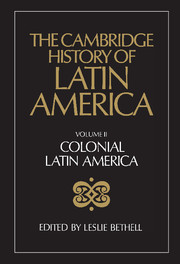Book contents
- Frontmatter
- PART ONE POPULATION
- PART TWO ECONOMIC AND SOCIAL STRUCTURES: SPANISH AMERICA
- 3 The urban development of colonial Spanish America
- 4 Mining in colonial Spanish America
- 5 The formation and economic structure of the hacienda in New Spain
- 6 The rural economy and society of colonial Spanish South America
- 7 Aspects of the internal economy of colonial Spanish America: labour; taxation; distribution and exchange
- 8 Social organization and social change in colonial Spanish America
- 9 Women in Spanish American colonial society
- 10 Africans in Spanish American colonial society
- 11 Indian societies under Spanish rule
- PART THREE ECONOMIC AND SOCIAL STRUCTURES: BRAZIL
- PART FOUR INTELLECTUAL AND CULTURAL LIFE
- Bibliographical essays
7 - Aspects of the internal economy of colonial Spanish America: labour; taxation; distribution and exchange
from PART TWO - ECONOMIC AND SOCIAL STRUCTURES: SPANISH AMERICA
Published online by Cambridge University Press: 28 March 2008
- Frontmatter
- PART ONE POPULATION
- PART TWO ECONOMIC AND SOCIAL STRUCTURES: SPANISH AMERICA
- 3 The urban development of colonial Spanish America
- 4 Mining in colonial Spanish America
- 5 The formation and economic structure of the hacienda in New Spain
- 6 The rural economy and society of colonial Spanish South America
- 7 Aspects of the internal economy of colonial Spanish America: labour; taxation; distribution and exchange
- 8 Social organization and social change in colonial Spanish America
- 9 Women in Spanish American colonial society
- 10 Africans in Spanish American colonial society
- 11 Indian societies under Spanish rule
- PART THREE ECONOMIC AND SOCIAL STRUCTURES: BRAZIL
- PART FOUR INTELLECTUAL AND CULTURAL LIFE
- Bibliographical essays
Summary
Colonies are structured by those who rule them to benefit the mother country and its ruling classes. To the extent that these rulers are successful in this aim colonies are, in Chaunu's word, extrovert. They are, at least in part, organized economically to send out to others significant portions of their most valuable or profitable raw materials and products. In colonial Spanish America much of the economic history which we know has emerged from studies of Spanish attempts to make the colonies serve metropolitan needs. One result has been an emphasis on the sea link, the carrera de Indias, and the fleet system. We know a fair amount about who went to the Indies and when, and what goods were carried in each direction across the Atlantic, more especially from Spanish America to Spain. Within Spanish America itself economic historians have allowed their interests to be shaped to some extent by what primarily interested the Spanish crown: above all, silver and gold mining and plantation agriculture, the bases of the great export trades, and the supply of labour to the mines and plantations. We know much less about the basic institutions, assumptions, systems and practices of the internal economy of colonial Spanish America. Drawing on the available secondary literature, which concentrates on a limited range of topics and regions, an attempt will be made in this chapter to examine three aspects of the internal economy: labour systems; taxation; and trade within the empire, both local and long-distance.
- Type
- Chapter
- Information
- The Cambridge History of Latin America , pp. 219 - 264Publisher: Cambridge University PressPrint publication year: 1984
- 1
- Cited by



